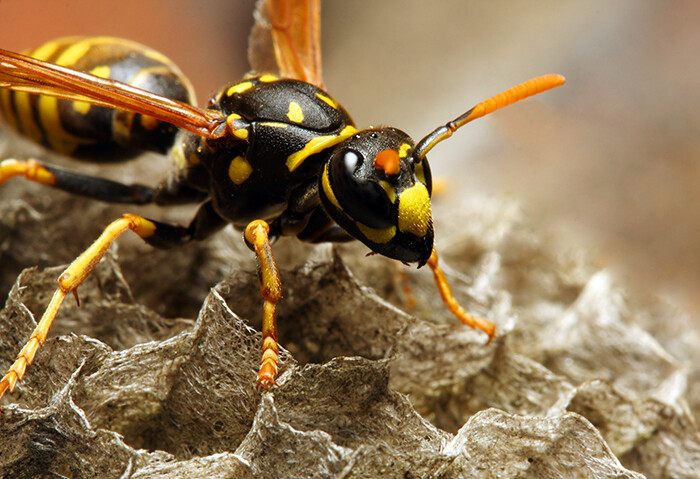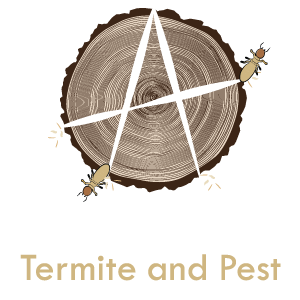 Insects that are a stinging hazard in Virginia are numerous; however, it is the paper wasps, bald-faced hornets, yellow jackets, and European hornets that are the more commonly encountered.
Insects that are a stinging hazard in Virginia are numerous; however, it is the paper wasps, bald-faced hornets, yellow jackets, and European hornets that are the more commonly encountered.
Yellow Jackets
One of the most common stinging insects encountered in Virginia is the yellow jacket. These pests build their nests underground or in protected locations above ground and if threatened or disturbed, they “boil” out of their nest and begin stinging ferociously to defend their nest.
Yellow Jackets are widely distributed throughout Virginia and are often seen during early fall picnics, outside parties, and other places where they are attracted to food odors, especially the sugars found in soft drinks as well as the proteins found in meats.
Paper Wasps
These insects are easy to identify because they construct their nests from plant material mixed with their saliva, thus forming a thin material that looks like paper. Their nests include numerous easily seen compartments where fertile females lay their eggs and rear their young. Unlike yellow jackets, paper wasps build nests in fairly exposed yet sheltered areas. Examples of such locations include door frames, windowsills, under the eaves of houses, and in corners of garages and outdoor sheds. Paper wasps feed on nectar and pollen, although they also prey on insects and spiders.
 Bald-faced Hornets
Bald-faced Hornets
Bald-faced hornets are widely distributed in Virginia. They are very aggressive and up to about an inch long. The common name of this insect comes from its mainly black coloration, except for its predominantly white face. Bald-faced hornets nest above ground and build their large, aerial, grey paper-like nest in trees and sometimes-large shrubs. Another sign of the bald-face’s nest is a single opening to the nest, which is always guarded by a few hornets at the nest entrance.
Since the worker hornets are killed by the cold weather in the late fall, females from the nest that are fertilized by males seek shelter to overwinter in protected places. These fertile females will be the future queens of the next year’s nest. Nests are abandoned each year, although they will remain intact if not destroyed by animals or the effects of rain, cold weather, and winds.
European Hornets
European hornets, sometimes called giant hornets or brown hornets, are not as aggressive as bald-faced hornets, but will sting if their colony is disturbed. European hornets prefer to construct nests in secluded, aboveground locations, such as hollow trees, attics, porches and inside wall voids. The European hornet is the only species of true hornet located in the U.S.
Benefits Of Bees
Many bees are commercially valuable and an important part of our ecosystem, but in the wrong place at the wrong time, wasps and bees can become a serious pest. If you think you may have a bee infestation, Ashcraft Termite and Pest can help you first determine whether you’re actually dealing with wasps or bees. It is important to distinguish between the various wasps and bees because their potential as problems and their control differ.
Occasional encounters with bees, wasps, yellow jackets are inevitable and stinging insects are beneficial, but they can be a problem when they choose a nest site too close to your home. Most “problem” insects are social rather than solitary. This means that large numbers work and live together in the same nest. The nests may be built in or around human dwellings, making frequent encounters more likely. A person’s proximity to the nest also increases their chance of being attacked by multiple individuals. Even solitary-nesting insects can be a nuisance. For example, carpenter bees tunnel into wood structures, and cicada killer wasps excavate burrows in the lawn. Methods of treatment vary depending on the specific insect and location of the nest.
If our experts determine that the insects are honey bees, they will refer you to a local beekeeper who will in many cases be able to remove and preserve the hive. The beekeepers do not charge for the hives removal. The bees are still gone, but their environmental benefits remain!
The discovery of a bee nest or swarm generally creates a real sense of urgency. You may become anxious about the safety of your family, pets and property, and you will have an immediate desire to eradicate the bees. However it is important to remain calm.
Ashcraft Termite and Pest is ready to solve your current or potential problems with hornets, bees and wasps. CONTACT US


